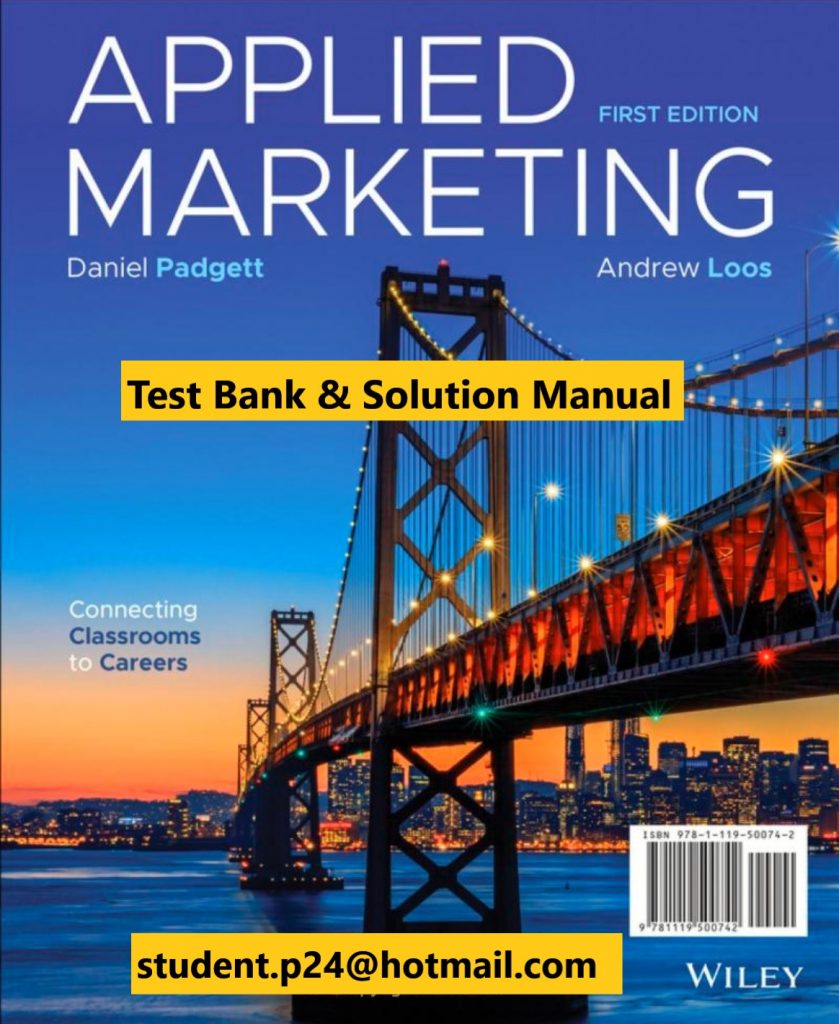My name is Jone im from USA i want to get this solutions manual / test bank of:
book name :
Applied Marketing
ISBN: 978-1-119-50068-1 February 2019 352 Pages
if you can send the ISBN NUMBER of your textbook
(You can use the 10 digit ISBN or 13 digit ISBN), this will be good ,
Applied Marketing is a concise product that provides the very latest examples of marketing techniques and campaigns from today’s business world without compromising on traditional theories of marketing. Marketing is about decision making and professors want material that will help students develop their critical thinking skills so they can think like a marketer and see that marketing is everywhere around them. Who better to develop such a product than a practitioner, Andrew Loos of Attack Marketing, and an academic, Daniel Padgett of Auburn University. Together these authors provide insights into what employers need, know the latest tools used by companies today and can help students smoothly move from the classroom to their careers. Applied Marketing connects traditional marketing with customer-perspective marketing, thus teaching students the value of allowing customers to feel more connected to the product, brand and company.
TABLE OF CONTENTS
1. What is Marketing
2. Marketing Strategy
3. The Marketing Environment
4. Customer Behavior
5. Research in Marketing
6. Segmentation, Targeting, and Positioning
7. Applying the Marketing Mix
8. Products, Brands, and Customer Needs
9. Place Decisions and Customer Convenience
10. Managing Price and Customer Cost Perceptions
11. Promoting to Communicate with Customers
12. Encouraging Participation to Connect with Customers
13. Measuring Marketing Effectiveness Through Metrics
14. Developing an Integrated Marketing Mix
15. Finalizing a Marketing Plan
FEATURES
- Extensive, Current and Engaging Videos: Course content is delivered in a highly engaging and practical way through the use of videos. These include industry expert interview videos highlighting the experiences of marketing leaders and how their experiences relate to the content along with author concept videos recorded in a relaxed, conversational, roundtable style that focuses on commonly asked questions.
- Author Concept Videos: Key concepts and examples for each learning objective are discussed by the authors via engaging conversations and stories. The author videos feature common FAQs students have when studying the material and focuses on classroom and career application.
- Industry Expert Interviews: A guest interview series with CEOs, thought leaders, brand executives, and agency leaders brings students varying perspectives of marketing from within different industries.
- Mini-cases: Mini-cases in each course section provide examples of what a campaign looks like in a real marketing agency.
- Running Case: A running case provides access to real company intelligence linked to application exercises at the end of each section.
- Company Field Trips: Application of marketing principles at select companies are highlighted through a tour of the company.
- Case Studies: Case studies are available for each course section. In addition, a running case that applies the principles covered throughout the course to a single company allows students to see multiple marketing strategies applied to the same product, and provides hands-on participation in the market plan development of a new product.
- Classroom to Career Resources: All aspects of the course and supporting resources were created to bridge the gap between the classroom and careers. “Career Center Resources” include career coaching videos, tools to create an e-portfolio, and job/internship search resources.
- Adaptive Practice: Every student has a different starting point, and adaptive practice provides endless opportunities for practice to effectively prepare for class or quizzes and exams. Active retrieval of information with practice questions is proven to improve retention of information better than re-reading or reviewing the material, and students who use adaptive practice to prepare for exams do significantly better than those who do not. Students begin with a quick, section-level diagnostic to determine their initial level of understanding, and they can use the dashboard and quick reports to see what topics they know and don’t know.
